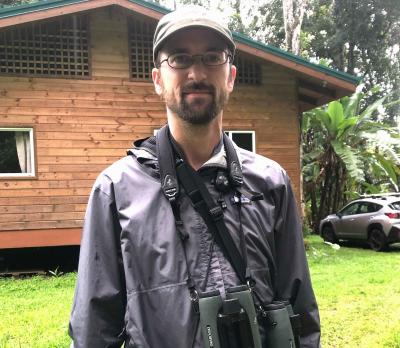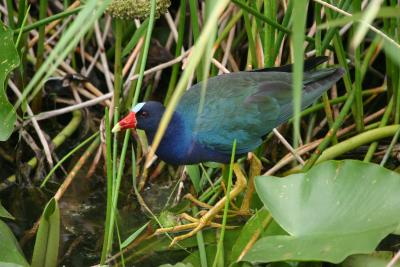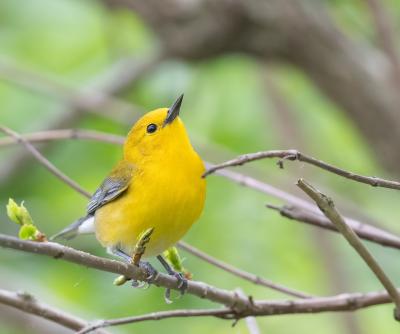Angola
-
Jul 2027
Ethan Kistler
The combination of varied habitats, high species diversity and a significant number of endemics and specialties make Angola a remarkable if little known African birding destination. With habitats ranging from Congo Basin and Afromontane forests to the Namib Desert, it’s no surprise that the country has a bird list of about 950 species.
We’ll begin by sampling the northern escarpment forests near Uíge where numerous Congo Basin birds occur alongside the endemic Braun’s Bushshrike, followed by a visit to the broadleaf woodlands and gallery forests of the Kalandula area, which host forest specialties such as White-headed Robin-Chat, as well as miombo (Brachystegia woodlands) species such as Sharp-tailed Starling. We’ll move on to the central escarpment where Kissama National Park has dry forests at the escarpment foot while the Kumbira Forest contains slightly moister forests at the top of the escarpment. Together these two sites hold almost half of Angola’s endemics and special birds, including Red-crested Turaco, White-fronted Wattle-eye, and Golden-backed Bishop.
We’ll also explore the varied Mount Moco region’s Afromontane forests, montane grasslands and miombo woodlands. Here we’ll hope to see Fülleborn’s Longclaw, Dusky Twinspot, Black-and-rufous Swallow, and Brazza’s Martin. Heading towards the arid coast, we’ll then enter the northernmost tongue of Kalahari and Namibian escarpment habitat where birds such as Hartlaub’s Francolin and White-tailed Shrike can be found.
The tour ends in the Lubango area, where we’ll visit Tundavala in search of Angola Cave Chat among others, and we’ll make a day trip to the coastal deserts to look for Rüppell’s Korhaan and Benguela Long-billed Lark.
Day 1: The tour begins this evening in Luanda. Night in Luanda.
Day 2: After a quick look at the large dark swifts—currently thought to be dark Mottled Swifts—near our hotel, we’ll head northeast on the road to Uíge. Our first stop will be a walk in dry forest where we should see our first endemics. Red-backed Mousebird and Bubbling Cisticola are usually present, and Gabela Helmetshrike and Monteiro’s Bushshrike are both possible. As we approach Uíge in the afternoon, we’ll stop in moister roadside forest to look for our first chance of Braun’s Bushshrike. Night in Uíge.
Day 3: We’ll spend a full day exploring various patches of northern escarpment forest within an hour’s drive of Uíge. Braun’s Bushshrike is the main target, but many other species are possible including: Red-fronted Parrot; Piping Hornbill; Yellow-crested Woodpecker; Speckled and Red-rumped Tinkerbirds; Yellow-billed, Naked-faced, Bristle-nosed and Hairy-breasted Barbets; Cassin’s Honeybird; Black Bee-eater; Banded Prinia; Lowland Masked Apalis; Brown-backed Scrub Robin; Forest Chestnut-winged Starling; Black-winged Oriole; Dusky-blue and Sooty Flycatchers; Brown Twinspot; Yellow-browed Camaroptera; Rufous-crowned Eremomela; White-breasted Nigrita; and Orange-tufted, Green-throated, and Little Green Sunbirds. White-collared Oliveback, discovered here in 2011, is also possible but rare. Night in Uíge.
Day 4: After some final birding in the Uíge area, we’ll drive to Kalandula Falls, stopping at various gallery forests and woodlands en route. Possible new birds for the day include Red-crested Turaco. Night in Kalandula.
Day 5: Our main reason for visiting the Kalandula region is to search for the striking and localized White-headed Robin-Chat in the gallery forests some 25 miles north of the falls. Sharing the same habitat are species such as Narina Trogon, Grey-winged Robin-Chat, Bannerman’s Sunbird, Brown-headed Apalis, African Broadbill, and Cabanis’s Greenbul. We’ll also explore the surrounding woodlands which are the most reliable site for Anchieta’s Barbet and Sharp-tailed Starling. Other species of interest may include Pale-billed Hornbill, Rufous-bellied Tit, Anchieta’s and Western Violet-backed Sunbirds, Red-throated Cliff Swallow, Meyer’s Parrot, Retz’s Helmetshrike, and Miombo Scrub Robin. Night in Kalandula.
Day 6: We’ll drive to Muxima on the Kwanza River in Kissama National Park. We’ll pause near N’dalatando for a bit of escarpment forest birding but aim to arrive at Muxima in time for introductory birding in the general area. Night in Muxima.
Day 7: Dry forests in the vicinity of Muxima provide some of the country’s most endemic-rich birding. In the early morning we’ll watch for Grey-striped Francolin on the roadside. As the day progresses, a host of dry forest birds are on offer with Gabela Helmetshrike, Monteiro’s Bushshrike and White-fronted Wattle-eye topping of the list. Other possible species include African Barred Owlet, Red-backed Mousebird, Olive Bee-eater, Scaly-throated Honeyguide, Pale-olive Greenbul, Swamp Boubou, Rufous-tailed Palm Thrush, Bubbling Cisticola, Forest Scrub Robin, Green Crombec, Purple-banded Sunbird, Yellow-throated Nicator, and Angola Batis. Night in Muxima.
Day 8: After some final birding in the Muxima area, we’ll drive down the drier coast, birding the coastal wetlands of Lobito, home to Cape Teal and a variety of herons and waders. Night in Benguela.
Day 9: The arid savanna and rocky hillsides some 30 miles inland of Benguela form the most northerly tongue of Namibia’s Great Escarpment habitat and provide an opportunity to look for several species mostly associated with Namibia. Hartlaub’s Francolin call from the rocks in the early morning, and we hope to find Bare-cheeked Babbler, Rüppell’s Parrot, White-tailed Shrike, Cape Penduline Tit, Carp’s Tit, Pririt Batis, Monteiro’s Hornbill, and Southern Yellow-billed Hornbill. Night in Lubango.
Day 10: The views down the southern escarpment from Tundavala near Lubango are spectacular, and the rocky area also holds a variety of grassland, escarpment, and forest birds. The main attraction here is the localized Angola Cave Chat, but it’s found alongside Swierstra’s Francolin (rare), Freckled Nightjar, Bradfield’s Swift, Angola Slaty Flycatcher, Short-toed Rock Thrush, Angola Swee Waxbill, Rockrunner, Tinkling and Wailing Cisticolas, Buffy and Striped Pipits, Oustalet’s Sunbird, and Ansorge’s Firefinch (split from Jameson’s Firefinch). We’ll also search for the recently rediscovered Angola White-headed Barbet. Night in Lubango.
Day 11: The road from Lubango to Namibe starts on the Humpata Plateau at around 7,500 feet elevation and rapidly drops through the spectacular Leba Pass to the lowlands below. Our first stop will be at the base of the escarpment where we hope to track down Cinderella Waxbill, Hartlaub’s Babbler, Bennett’s Woodpecker, and Benguela Long-tailed Starling. As we drive west towards the coast, the habitat becomes drier and drier. The arid bushveld is home to Dusky Sunbird, Karoo Chat, Chat Flycatcher, Cape Sparrow, and Southern Fiscal, and we’ll later reach barren desert plains where Benguela Long-billed Lark and Rüppell’s Korhaan are the main targets. Other possibilities include Ludwig’s Bustard, Double-banded Courser, Pale Chanting Goshawk, Greater Kestrel, Pale-winged Starling, Grey-backed Sparrow-Lark, and Stark’s Lark. Night in Lubango.
Day 12: Today is a travel day, as we start our journey back north to Luanda, this time taking the inland route through miombo woodlands. Night near Huambo.
Days 13-14: The greater Mount Moco region is one of the most diverse in the country, and we’ll have two days to explore its Afromontane forests, montane grasslands, miombo woodlands, and dambo grasslands. A significant amount of time will be focused on Mount Moco itself, where the forests support diminishing populations of Swierstra’s Francolin, Ludwig’s Double-collared Sunbird, Bocage’s Akalat, White-tailed Blue Flycatcher, Olive Woodpecker, Western Green Tinkerbird, and Black-backed Barbet. The forest edge also supports Huambo Cisticola (Angola’s newest bird species), Yellow-throated Leaflove, Dusky Twinspot, Angola Swee Waxbill, Black-throated Wattle-eye, Oustalet’s Sunbird, Bronzy Sunbird, Spotted Creeper, Red-throated Wryneck, and Black-chinned Weaver. The surrounding grasslands and rocky areas hold an endemic race of Mountain Wheatear, Horus Swift, Striped Pipit, Black-collared Bulbul, Angola Lark, Broad-tailed Warbler (Fan-tailed Grassbird), and the very hard-to-see Finsch’s Francolin.
Miombo woodlands and dambo grasslands surrounding Mount Moco hold an equally impressive variety of birds. Black-necked and Green-capped Eremomelas, the curious local race of Brubru, Miombo Scrub Robin, Miombo Pied Barbet (rare), Miombo Wren-Warbler, Red-capped Crombec, Woodland Pipit, Salvadori’s Eremomela, Pale-billed Hornbill, Yellow-bellied Hyliota, and White-breasted Cuckooshrike may be seen in the woodlands. However, the dambo grasslands are of greatest interest, and here we’ll be hoping to find Brazza’s Martin, Black-and-rufous Swallow, Fülleborn’s Longclaw, Sooty Chat, Chirping Cisticola, Fawn-breasted Waxbill, Coppery-tailed Coucal, Brown Firefinch, Locust-Finch, Hartlaub’s Marsh Widowbird, Bocage’s Sunbird, and Bocage’s Weaver. Nights near Huambo.
Day 15: After some final birding in the Mount Moco region, we’ll make our way to the central escarpment. Night near Conda.
Day 16: Kumbira Forest is home to three endangered central-scarp endemics—namely Pulitzer’s Longbill, Gabela Bushshrike and Gabela Akalat. Unfortunately, slash-and-burn farming has caused major population declines in all three species, although the akalat is still common and the longbill is normally not too hard to find. The bushshrike has become rare and difficult to locate, having been fairly common only 15 years ago, so we may have to search for it at some backup sites. Other birds we may find at Kumbira include: Red-crested Turaco; Angola Naked-faced Barbet; hyliotas of uncertain affinity; Dusky Tit; Yellow-throated Nicator; Yellow-necked and Pale-olive Greenbuls; Brown Illadopsis; Hartert’s Camaroptera; Yellow-bellied Wattle-eye; Forest Scrub Robin; Gorgeous Bushshrike; Pink-footed Puffback; African Broadbill; Blue-headed Crested Flycatcher; Superb Sunbird; Black-faced Canary; and Grey Waxbill. Night near Conda.
Day 17: After some final birding in the Kumbira Forest area, we’ll return to the coast and drive north back to Luanda where the tour ends this evening.
Note: The information presented below has been extracted from our formal General Information for this tour. It covers topics we feel potential registrants may wish to consider before booking space. The complete General Information for this tour will be sent to all tour registrants and of course supplemental information, if needed, is available from the WINGS office.
ENTERING ANGOLA: United States citizens need a passport valid for at least six months beyond your date of entry and with at least one blank page for an entry stamp, and a tourist visa. Proof of a Yellow Fever vaccination is also required.
Citizens of other nations may need a visa and should contact their nearest Angolan Embassy for entry requirements required by the embassy or visa-granting entity, WINGS can provide a letter for you to use regarding your participation in the tour.
COUNTRY INFORMATION: You can review the U.S. Department of State Country Specific Travel Information here: https://travel.state.gov/content/travel.html. Review foreign travel advice from the UK government here: https://www.gov.uk/foreign-travel-advice and travel advice and advisories from the Government of Canada here: https://travel.gc.ca/travelling/advisories.
PACE OF TOUR: This is not a particularly strenuous tour. Most walks are reasonably short and over good terrain. There may be one demanding hike when we visit Mount Moco, and there may be one or two other locations where we encounter some uneven ground or need to push through vegetation. As this tour is based entirely in hotels, and does not involve camping, there will be the need for some early starts to reach certain locations.
HEALTH: The Centers for Disease Control and Prevention (CDC) recommends that all travelers be up to date on routine vaccinations. These include measles-mumps-rubella (MMR) vaccine, diphtheria-tetanus-pertussis vaccine, varicella (chickenpox) vaccine, polio vaccine, and your yearly flu shot.
They further recommend that most travelers have protection against Hepatitis A and Typhoid.
Please contact your doctor well in advance of your tour’s departure as some medications must be initiated weeks before the period of possible exposure.
Yellow Fever: A vaccination is required for entry into Angola.
Malaria: A malaria prophylaxis is recommended. Note that according to the CDC, Chloroquine is not an effective antimalarial drug in Angola.
The most current information about travelers’ health recommendations can be found on the CDC’s Travel Health website at https://wwwnc.cdc.gov/travel/destinations/traveler/none/angola.
Smoking: Smoking or vaping is prohibited in the vehicles or when the group is gathered for meals, checklists, etc. If you are sharing a room with a non-smoker, please do not smoke in the room. If you smoke in the field, do so well away and downwind from the group. If any location where the group is gathered has a stricter policy than the WINGS policy, that stricter policy will prevail.
CLIMATE: We are visiting Angola at the end of the dry season. Although we are unlikely to encounter much rain, some light showers are possible. It will mostly be warm and sunny, but temperatures in the highlands are cooler and it can sometimes be windy.
ALTITUDE: Most of our birding is done at relatively low altitudes with some birding at 2000m.
ACCOMMODATION: Unlike other tours to Angola which use camping, this one is based entirely at hotels. The quality does vary but generally they are all of a reasonable standard. The only issue tends to be a lack of maintenance with various things such as plumbing and some lights not working. All the hotels have en suite facilities.
Internet & Mobile Phone Access: Mobile phone coverage is reasonably extensive and you will have reception on most nights, although roaming often does not function. Local SIM cards may be available at the airport. Some hotels have WiFi but it can slow.
FOOD: Food is mostly Angolan/Portuguese, which is generally heavily meat- and starch-based. Breakfasts will be simple: tea, coffee, cereal, fruit, bread and jam, and sometimes eggs. Lunches will be light and mostly taken in the field.
Drinks: Bottled water, a soft drink or a beer are provided at meals, as is coffee or tea. In addition we keep a supply of bottled water on the tour vehicles.
Food Allergies/Requirements: We cannot guarantee that all food allergies can be accommodated at every destination. Participants with significant food allergies or special dietary requirements should bring appropriate foods with them for those times when their needs cannot be met. Announced meal times are always approximate depending on how the day unfolds. Participants who need to eat according to a fixed schedule should bring supplemental food. Please contact the WINGS office if you have any questions.
TRANSPORTATION: We will be travelling in one or two 4x4 vehicles. Participants should be able and willing to ride in any seat in our tour vehicles. The leader will arrange a seating rotation. Please note that while many of Angola’s main roads have been resurfaced in the last few years, some sections are under construction which means we will be driving on some small, bumpy tracks.
Rooms with two beds may not be available at all accommodations.
This tour is offered every other year on odd-numbered years.
Maximum group size nine with two leaders.












